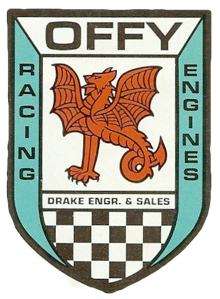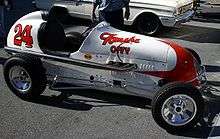Offenhauser
 | |
| Industry | Automotive |
|---|---|
| Founded | 1933 |
| Founder | Fred H. Offenhauser and |
| Products | Racing engines |
The Offy or Offenhauser Racing Engine is a racing engine design that dominated American open wheel racing for more than 50 years and is still popular among vintage sprint and midget car racers.
History

The Offenhauser engine, familiarly known as the "Offy", was developed by Fred Offenhauser and his employer Harry Arminius Miller.[1] Originally, it was sold as a marine engine. In 1930, a four-cylinder 151 cu in (2.47 l) Miller engine installed in a race car set a new international land speed record of 144.895 mph (233.186 km/h). Miller developed this engine into a twin overhead cam, four-cylinder, four-valve-per-cylinder 220 cu in (3.6 l) racing engine. This would be used in midgets and sprints into the 1960s,[2] with a choice of carburetion or Hilborn fuel injection.[3] When Miller went bankrupt in 1933, Offenhauser bought the shop and the rights to the engine. He and another Miller employee, draftsman Leo Goossen, further developed the Miller into the Offenhauser engine. Then in 1946 the name and engine designs were sold to Louis Meyer and Dale Drake. Meyer was bought out by Drake, his wife Eve and their son John in 1965. From then until Drake's son John sold the shop to Stewart Van Dyne, the Drake family designed and refined the engine until its final race days. It was under Meyer and Drake that the engine dominated the Indy 500 and midget racing in the United States.[4]
One of the keys to the Offenhauser engine's success and popularity was its power. A 251.92 cubic inch (4,128.29 cm³) DOHC four-cylinder racing Offy with a 15:1 compression ratio and a 4.28125-by-4.375-inch (108.744 mm × 111.125 mm) bore and stroke, could produce 420 hp (310 kW) at 6,600 rpm (1.77 hp per cubic inch (81 kW/L). Other variants of the engine produced even higher outputs of 3 hp per cubic inch (137 kW/L). Another reason for the engine's success was its reliability; its monobloc construction meant it was not vulnerable to head gasket or cylinder stud problems, and allowed for higher cylinder pressures.
From 1934, through the 1970s, the Offenhauser engine dominated American open wheel racing, winning the Indianapolis 500 27 times. By then, the company had already been sold, right after World War II, to Meyer and Drake, who continued to build the engines. From 1950 through 1960, Offenhauser-powered cars won the Indy 500 and achieved all three podium positions, winning the pole position in 10 of the 11 years. In 1959 Lime Rock Park held a famous Formula Libre race, where Rodger Ward shocked the expensive and exotic sports car contingent by beating them on the road course in an Offenhauser powered midget car, which was normally considered competitive on oval tracks only.
When Ford came onto the scene in 1963, the Offy began to lose its domination over Indy car racing, although it remained a competitive winner through the mid-1970s even with the advent of turbocharging. Outputs over 1,000 bhp (750 kW) could be attained, using around 44.3 psi (3.05 bar) of boost pressure. The final 2.65-litre four-cylindar Offy, restricted to 24.6 psi (1.70 bar) boost, produced 770 bhp (570 kW) at 9,000 rpm. The Offy's final victory came at Trenton in 1978, in Gordon Johncock's Wildcat. The last time an Offy-powered car raced was at Pocono in 1982 for the Domino's Pizza Pocono 500, in an Eagle chassis driven by Jim McElreath, although two Vollstedt chassis with Offenhauser engines failed to qualify for the 1983 Indianapolis 500.
Common Offenhauser engines
Offenhauser produced engine blocks in several sizes. These blocks could be bored out or sleeved to vary the cylinder bore, and could be used with crankshafts of various strokes, resulting in a wide variety of engine displacements. Offenhauser (and Meyer-Drake, in later years) frequently made blocks, pistons, rods, and crankshafts to specific customer requests. However, certain engine sizes were common, and could be considered the "standard" Offenhauser engines:[4]
- 97 cu in (1.59 L) - to meet the displacement rule in many midget series
- 220 cu in (3.6 L) - displacement rule in AAA (later USAC) sprint cars
- 270 cu in (4.4 L) - displacement rule for the Indianapolis 500 under AAA rules
- 255 cu in (4.18 L) - for Indianapolis (during the 1930s fuel consumption rules)
- 252 cu in (4.13 L) - displacement rule for Indianapolis under USAC rules
- 168 cu in (2.75 L) - displacement rule for turbocharged engines at Indianapolis (to 1968)
- 159 cu in (2.61 L) - displacement rule for turbocharged engines at Indianapolis (1969 and later)
World championship Indy 500 summary
| Season | Cars entered | Winning driver | Second driver | Third driver | Pole sitter | Race report |
|---|---|---|---|---|---|---|
| 1950 | 31 | Johnnie Parsons | Bill Holland | Mauri Rose | Walt Faulkner | Report |
| 1951 | 32 | Lee Wallard | Mike Nazaruk | Manny Ayulo | Report | |
| 1952 | 30 | Troy Ruttman | Jim Rathmann | Sam Hanks | Fred Agabashian | Report |
| 1953 | 32 | Bill Vukovich | Art Cross | Sam Hanks | Bill Vukovich | Report |
| 1954 | 34 | Bill Vukovich | Jimmy Bryan | Jack McGrath | Jack McGrath | Report |
| 1955 | 35 | Bob Sweikert | Tony Bettenhausen | Jimmy Davies | Jerry Hoyt | Report |
| 1956 | 32 | Pat Flaherty | Sam Hanks | Don Freeland | Pat Flaherty | Report |
| 1957 | 31 | Sam Hanks | Jim Rathmann | Jimmy Bryan | Pat O'Connor | Report |
| 1958 | 31 | Jimmy Bryan | George Amick | Johnny Boyd | Dick Rathmann | Report |
| 1959 | 33 | Rodger Ward | Jim Rathmann | Johnny Thomson | Johnny Thomson | Report |
| 1960 | 33 | Jim Rathmann | Rodger Ward | Paul Goldsmith | Eddie Sachs | Report |
In their 11 world championship years, the Meyer-Drake Offenhauser engine partnered for at least one race with the following 35 constructors:
Complete Formula One World Championship results
(key)
| Year | Entrant | Chassis | Engine | Tyres | Drivers | 1 | 2 | 3 | 4 | 5 | 6 | 7 | 8 | 9 | 10 | Points | WCC |
|---|---|---|---|---|---|---|---|---|---|---|---|---|---|---|---|---|---|
| 1960 | Reventlow Automobiles Inc | Scarab F1 | L4 | D | ARG | MON | 500 | NED | BEL | FRA | GBR | POR | ITA | USA | 0 | - | |
| Chuck Daigh | DNA | DNQ | DNS | Ret | DNS | 10 | |||||||||||
| Lance Reventlow | DNQ | DNS | Ret | ||||||||||||||
| Richie Ginther | DNS |
References
- ↑ "Fred Offenhauser". National Midget Auto Racing Hall of Fame. 1999. Archived from the original on 2012-02-05. Retrieved 2008-09-06.
- ↑ Circle Track, 9/84, pp.82-3.
- ↑ Circle Track, 9/84, p.83.
- 1 2 Offenhauser by Gordon Eliot White